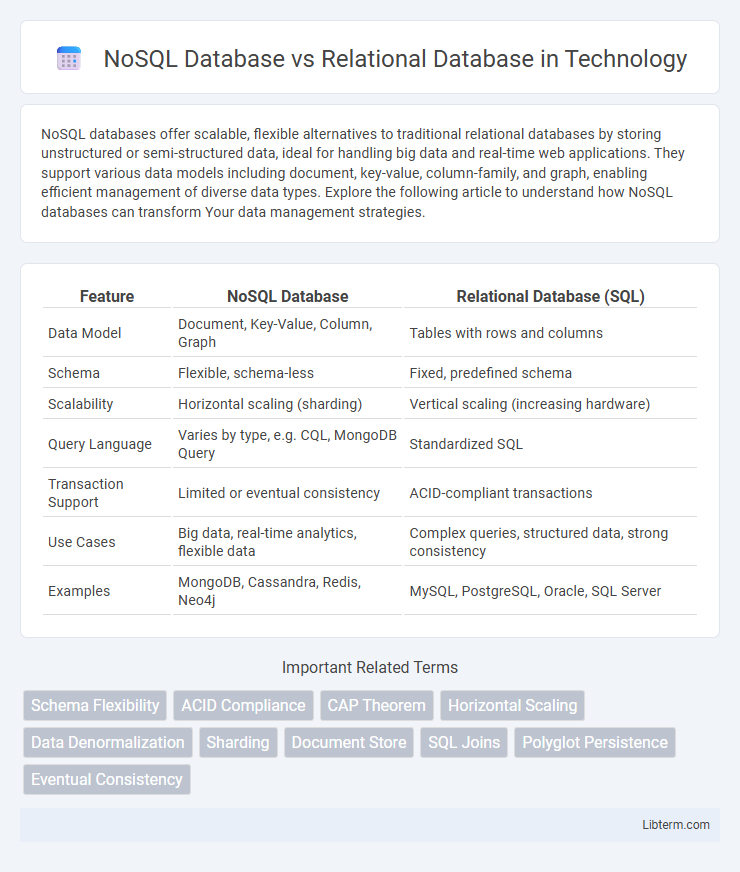NoSQL databases offer scalable, flexible alternatives to traditional relational databases by storing unstructured or semi-structured data, ideal for handling big data and real-time web applications. They support various data models including document, key-value, column-family, and graph, enabling efficient management of diverse data types. Explore the following article to understand how NoSQL databases can transform Your data management strategies.
Table of Comparison
| Feature | NoSQL Database | Relational Database (SQL) |
|---|---|---|
| Data Model | Document, Key-Value, Column, Graph | Tables with rows and columns |
| Schema | Flexible, schema-less | Fixed, predefined schema |
| Scalability | Horizontal scaling (sharding) | Vertical scaling (increasing hardware) |
| Query Language | Varies by type, e.g. CQL, MongoDB Query | Standardized SQL |
| Transaction Support | Limited or eventual consistency | ACID-compliant transactions |
| Use Cases | Big data, real-time analytics, flexible data | Complex queries, structured data, strong consistency |
| Examples | MongoDB, Cassandra, Redis, Neo4j | MySQL, PostgreSQL, Oracle, SQL Server |
Introduction to NoSQL and Relational Databases
NoSQL databases are designed to handle unstructured data, offering flexible schema models such as key-value, document, column-family, and graph formats, making them ideal for big data and real-time web applications. Relational databases use structured query language (SQL) to manage data organized into tables with predefined schemas, ensuring data integrity and support for complex join operations. The choice between NoSQL and relational databases depends on the required scalability, consistency, and the nature of the data being processed.
Core Concepts and Data Models
NoSQL databases use flexible schema designs such as document, key-value, column-family, and graph models to handle unstructured or semi-structured data, enhancing scalability and performance for big data and real-time applications. Relational databases rely on structured schemas with tables, rows, and columns, enforcing data integrity through ACID transactions and SQL queries, suitable for complex relationships and consistent data management. Core concepts of NoSQL emphasize horizontal scaling and schema flexibility, while relational databases focus on normalization, joins, and strong consistency.
Scalability and Performance Differences
NoSQL databases excel in horizontal scalability by distributing data across multiple servers, making them ideal for handling large volumes of unstructured or semi-structured data with low latency. Relational databases, while providing strong ACID compliance and complex querying capabilities, generally scale vertically, which can limit performance as data size and traffic grow. Performance in NoSQL systems often surpasses relational counterparts in write-heavy and real-time applications due to schema flexibility and eventual consistency models.
Data Consistency and Integrity
NoSQL databases offer flexible schema designs ideal for handling unstructured data but often use eventual consistency models, which can lead to temporary data inconsistencies. Relational databases enforce strong ACID (Atomicity, Consistency, Isolation, Durability) properties, ensuring immediate data consistency and integrity through structured schemas and transactional support. Choosing between NoSQL and relational databases depends on application requirements for consistency guarantees and data integrity levels.
Flexibility and Schema Design
NoSQL databases offer superior flexibility by allowing dynamic schema designs that accommodate unstructured or semi-structured data, making them ideal for evolving data models and real-time applications. Relational databases rely on predefined schemas with fixed tables and relations, optimizing data integrity and consistency but limiting adaptability to changing data requirements. This fundamental difference in schema design influences scalability, data storage efficiency, and the complexity of data migrations in varying use cases.
Use Cases and Industry Applications
NoSQL databases excel in handling large volumes of unstructured data, making them ideal for real-time web applications, big data analytics, and IoT solutions in industries like e-commerce, social media, and finance. Relational databases are preferred for structured data with complex relationships, supporting transaction-heavy applications in banking, enterprise resource planning (ERP), and customer relationship management (CRM) systems. Both database types offer unique advantages tailored to specific industry needs, with NoSQL enabling scalability and flexibility, while relational databases ensure data integrity and consistency.
Query Languages and APIs
NoSQL databases typically utilize flexible query languages like JSON-based queries or graph traversal languages, allowing for efficient handling of unstructured data, whereas relational databases rely on SQL (Structured Query Language) for managing structured data through predefined schemas. NoSQL APIs often support RESTful APIs or proprietary interfaces optimized for high scalability and distributed environments, while relational databases provide standardized APIs such as ODBC and JDBC for seamless integration with various applications. The choice between these query languages and APIs impacts performance, scalability, and development complexity depending on the use case and data model requirements.
Transaction Support and ACID vs. BASE
Relational databases provide strong transaction support by adhering to ACID principles--Atomicity, Consistency, Isolation, and Durability--ensuring reliable and consistent data processing. NoSQL databases often adopt the BASE model--Basically Available, Soft state, Eventual consistency--prioritizing scalability and flexibility over strict transaction guarantees. This fundamental difference makes relational databases ideal for complex transactional applications, while NoSQL fits use cases requiring high availability and distributed data handling.
Pros and Cons of NoSQL Databases
NoSQL databases offer high scalability, flexibility in handling unstructured data, and faster performance for large volumes, making them ideal for big data and real-time applications. However, they lack standardized query languages and ACID compliance, which may lead to consistency challenges and complex transaction management. This trade-off means NoSQL is suited for dynamic, distributed systems but less ideal for applications demanding strict data integrity or complex joins.
Pros and Cons of Relational Databases
Relational databases offer strong data integrity, ACID compliance, and support complex queries with SQL, making them ideal for structured data and transactional systems. However, they can struggle with horizontal scalability and handling unstructured or semi-structured data compared to NoSQL databases. The rigid schema design requires predefined table structures, which limits flexibility when dealing with evolving data models.
NoSQL Database Infographic

 libterm.com
libterm.com